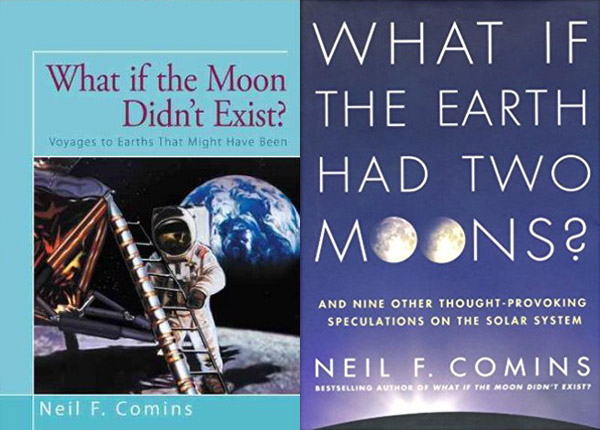QSF’s own Jim Comer reviews two great books for sci fi world builders.
Worldbuilding for writers and gamers means not only making imaginary worlds, but having a working knowledge of the laws by which worlds are built and operate. Knowledge of science is necessary in order for worlds to make any kind of sense. But one of the confusing parts of discussing worldbuilding is the lack of a convenient jargon.
Referring to a ‘wet Mars’ or a ‘cold Venus’ is only so useful; the fictional (“M-type”, in Star Trek, or the six-digit planetary profiles from the RPG Traveller)jargons have the disadvantage of being badly dated and usually having no scientific bases. And when a planet is called “Earth-like”, as often is the case, what exactly does that mean?
Neil F. Comins, an astronomer teaching at the University of Maine, specializes in study of galaxies. He has written a series of columns published across several years in Astronomy magazine. The short pieces have been collected into two books, What If The Moon Didn’t Exist? and a sequel, What If The Earth Had Two Moons? Each chapter explores one or two alternative Earths.
The chapters are introduced with bits of fiction, presenting the lives of humans dealing with the oddness of each world. Notably, SF authors have already used these books: Stephen Baxter’s Manifold: Origin features multiple alternate Earths built on Comins’ terms.
The scenarios are immediately obvious to worldmakers: Dimaan is an Earth with two moons and Solon has none. Mynoa is an Earth-sized moon orbiting a water-cloud gas giant, and Granstar is an Earth orbiting a giant Sun. While Comins has not referenced every variation, the twenty in these books cover many useful and human-habitable ideas, including a chapter on Earth colliding with a black hole (“Diablo”).
Now, of course, we world builders are free to use these scenarios. They’re appealingly detailed: (a world with a giant moon would develop sea travel later, because its ocean is wildly tidal; an Earth with a thickened crust would have huge volcanoes), andworth reading for that alone. But Comins has invented a useful terminology for alternate-astronomical Earths without necessarily intending to do so.
It’s easy, for example, having read the books, to classify Burroughs’ Barsoom as a Petiel(a tiny Earth) and his Amtor as a Solon (a moonless Earthlike world). My own ongoing worldbuilding project, Pendleton’s World, is a Mynoa (an Earthlike moon around a watercloud Jovian). These are convenient, easy-to-use terms which have intuitive meanings. I would suggest that if a simple descriptive terminology is needed, then Comins’ is both fitting and easy to expand.
Recommended for gamers and SF fans.
Comins, Neil F. What If The Moon Didn’t Exist? HarperCollins, 1993; What If The Earth Had Two Moons? St Martin’s, 2010.



